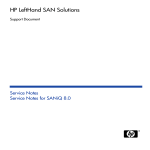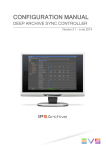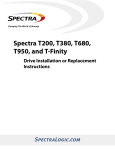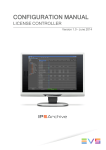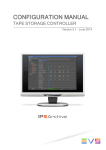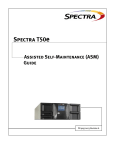Download IP2Archive user manual 1.2
Transcript
User Manual Version 1.2 - October 2012 IP2Archive Archive Digitization & Exploitation IP2Archive - User Manual - IP2Archive Version 1.2 Copyright EVS Broadcast Equipment S.A.– Copyright © 2003-2012. All rights reserved. Disclaimer The information in this manual is furnished for informational use only and subject to change without notice. While every effort has been made to ensure that the information contained in this user manual is accurate, up-to-date and reliable, EVS Broadcast Equipment cannot be held responsible for inaccuracies or errors that may appear in this publication. Improvement Requests Your comments will help us improve the quality of the user documentation. Do not hesitate to send improvement requests, or report any error or inaccuracy on this user manual by e-mail to [email protected]. Regional Contacts The address and phone number of the EVS headquarters are usually mentioned in the Help > About menu in the user interface. You will find the full list of addresses and phone numbers of local offices either at the end of this user manual (for manuals on hardware products) or at the following page on the EVS website: http://www.evs.tv/contacts. User Manuals on EVS Website The latest version of the user manual, if any, and other user manuals on EVS products can be found on the EVS download center, on the following webpage: http://www.evs.tv/downloadcenter. I EVS Broadcast Equipment S.A. - October 2012 Issue 1.2.D Table of Contents 1. INTRODUCTION 1 1.1. About IP2Archive 1 1.2. Requirements 1 1.2.1. Hardware Requirements 1 1.2.2. Software Requirements 1 1.2.3. Workflow Requirements 2 1.3. Hardware Setup 1.3.1. Overview Hardware Components 2 1.3.2. Description and Technical Specifications 2 1.4. Software Components 5 1.4.2. Deep Archive Manager 5 1.4.3. Deep Archive Sync 6 1.4.4. MAD Config 7 1.4.5. Communicator 8 1.4.6. Deep Archive Controller 9 1.4.7. Tape Storage Controller 10 1.4.8. File Transfer Daemon 11 1.4.9. IP2Archive Software Interaction 12 ARCHIVING AND RESTORING CLIPS 15 15 2.2. Archiving Clips 15 2.2.1. Before Archiving 15 2.2.2. Archiving Source Clips 16 2.2.3. Archiving Subclips 17 17 2.3.1. Before Restoring 17 2.3.2. Fully Restoring Clips 17 2.3.3. Partially Restoring Clips 19 2.3.4. Offline Files 19 2.4. Tracking the Archive and Restore Process II 14 2.1. Archive and Restore Bin Hierarchy 2.3. Restoring Clips 3. 5 1.4.1. Overview Software Components 1.5. Workflow 2. 2 19 2.4.1. Archive Metadata 19 2.4.2. Archive Status 20 2.4.3. Moving Clips From Bin to Bin 21 CONFIGURING IP2ARCHIVE 22 IP2Archive - User Manual - IP2Archive Version 1.2 3.1. Configuring the IPDirector API Connection 22 3.2. Creating an Archive and Restore Bin Hierarchy 23 3.3. Creating User Fields 23 3.4. Configuring IP2Archive Applications 24 III EVS Broadcast Equipment S.A. - October 2012 IV Issue 1.2.D IP2Archive - User Manual - IP2Archive Version 1.2 1. Introduction 1.1. About IP2Archive IP2Archive is an add-on for IPDirector that facilitates the connectivity between IPDirector and a third party hierarchical storage management system (HSM) and LTO tape library. It allows easy archiving and (partial) restoring of video clips and makes it possible to keep track of the archive and restore progress and status (in cache, online, offline, on tape) of each video clip. 1.2. Requirements 1.2.1. Hardware Requirements 1.2.2. 1. Introduction • A nearline storage should be present. • An XTAccess server containing XTAccess should be present. Software Requirements • At least IPDirector 5.99.30 and 6.07.90 (API version). • In IPDirector XTAccess must be configured for creation of low-resolution files. • Remote access to the IP2Archive setup for EVS support and maintenance. 1 EVS Broadcast Equipment S.A. - October 2012 1.2.3. Issue 1.2.D Workflow Requirements • The high-resolution and low-resolution video files should be stored on a nearline storage. • The low-resolution video files and their metadata XML file must be available. However, if deleted by accident, they can be restored using the Deep Archive Sync application. • The VarID must be unique for a media asset. • The VarID of the low-resolution and high-resolution video file must be the same. 1.3. Hardware Setup 1.3.1. Overview Hardware Components By default, the IP2Archive system consists of the following hardware components: • Oracle database server • Application server • Managment server • Third party network switch (Cisco) • Third party Hierarchical Storage Management system (HSM): DIVArchive (DIVA) from Front Porch Digital and XenData from XenData • Third party LTO tape library (Spectralogic) We support any hardware here because this should be supported by the HSM system. The following hardware components can be added for failover and performance: 1.3.2. • Oracle failover database server • Additional application servers Description and Technical Specifications Oracle Database Server The Oracle database server has redundant power supplies and redundant memory. The system drives containing the operating system (Linux 5.4 x64) and Oracle software are configured in RAID 1 (mirror). The data drives are configured in RAID 5. 2 1. Introduction IP2Archive - User Manual - IP2Archive Version 1.2 Weight Power BTU 16 kg 675 Watts # power sockets 2260 2 BTU/h Hardware CPU IBM System 2x Intel X3650 M3 Xeon E5620 RAM Hard Disk 24GB 2x 73GB SAS (RAID1) + 6x 300GB SAS (RAID5) Oracle Failover Database Server The failover database server runs Oracle Data Guard. Oracle Data Guard ensures high availability, data protection and disaster recovery and synchronizes with the main Oracle database server. It has redundant power supplies and redundant memory. The system drives containing the operating system (Linux 5.4 x64) and Oracle software are configured in RAID 1 (mirror). The data drives are configured in RAID 5. Weight Power BTU 16 kg 675 Watts # power sockets 2260 2 BTU/h Hardware CPU IBM System 2x Intel X3650 M3 Xeon E5620 RAM Hard Disk 24GB 2x 73GB SAS (RAID1) + 6x 300GB SAS (RAID5) Application Server The application server is the central server containing all the applications necessary to run the solution. It runs Windows 2008 R2x64. The application server runs all background applications needed for archiving and restoring. It has redundant power supply and two drives in RAID 1 (mirror). Multiple application servers can be used for performance reasons. Weight Power BTU # power sockets 11 kg 2 320 Watts 1093 BTU/h Hardware CPU XT Access 2x Intel I7 HP Xeon E5620 RAM Hard Disk 4GB 2x 250GB (RAID1) Management Server The management server runs Windows 7. It is the server on which the applications are running used to manage and monitor the IP2Archive system. This server must allow remote access for EVS support and maintenance purposes. 1. Introduction 3 EVS Broadcast Equipment S.A. - October 2012 Issue 1.2.D Weight Power BTU # power sockets 11 kg 2 320 Watts 1093 BTU/h Hardware CPU RAM Hard Disk XT Access I7 HP Intel I7 950 4GB 2x 250GB (RAID1) Cisco Catalyst Ethernet Switch Connects the various network devices. Series: 3750-E or 3750-X. Weight Power 10 kg BTU # power sockets 212 Watts 1023 BTU/h 2 Third Party HSM System IP2Archive can be used in combination with the following HSM systems: • Front Porch Digital DIVArchive • XenData Digital Archive See the websites of the manufacturers for the functional and technical specifications. Third Party LTO Tape Library If EVS may supply the LTO tape library, then it will be a tape library by Spectralogic. If the LTO tape library is not supplied by EVS, then only the HSM software is supported. The following Spectralogic LTO tape libraries are supported: • T50e • T120 • T200 T50e • Technical specifications: see www.spectralogic.com. • Capacity and throughput Media Max Drives Max Slots/Tapes Max Capacity Max Throughput LTO-6 4 50 400 TB 7.5 TB/h LTO-5 4 50 150 TB 4.0 TB/h T120 4 • Technical specifications: see www.spectralogic.com. • Capacity and throughput 1. Introduction IP2Archive - User Manual - IP2Archive Version 1.2 Media Max Drives Max Slots/Tapes Max Capacity Max Throughput LTO-6 10 120 960 TB 19 TB/h LTO-5 10 120 360 TB 10.1 TB/h T200 • Technical specifications: see www.spectralogic.com • Capacity and throughput Media Max Drives Max Slots/Tapes Max Capacity Max Throughput LTO-6 8 200 1.6 PB 15.1 TB/h LTO-5 8 200 600 TB 8.1 TB/h 1.4. Software Components 1.4.1. Overview Software Components IP2Archive is a modular system. It consists of several software components each with a specific function, running on the application server connected to the IP2Archive database. The following software components can be distinguished: • Deep Archive Manager • Deep Archive Sync • MAD Config • Communicator • Deep Archive Controller • Tape Storage Controller • File Transfer Daemon The Tape Storage Controller is only used when IP2Archive interfaces with the hierarchical storage management system DIVArchive by Front Porch Digital. The File Transfer Daemon is only used when IP2Archive interfaces with the hierarchical storage management system by XenData. 1.4.2. Deep Archive Manager The Deep Archive Manager can be considered as the portal to the deep archive system. It gathers the clips that have been requested in IPDirector to be archived or restored, but it can also display clips that originate from other sources (e.g. non-linear editing or playout systems) and that also need to be archived. It allows a user to decide which clips will be archived and restored and which clips will be excluded from the archive. Once clips have been archived, Deep Archive Manager allows you to manually initiate the removal of the 1. Introduction 5 EVS Broadcast Equipment S.A. - October 2012 Issue 1.2.D high-resolution video file from the nearline storage and also the removal of archived clips from LTO. The progress of the archive, restore, purge and high-resolution removal process can be monitored and the status of each clip can be seen. This application is installed on the management server. See the Deep Archive Manager user manual for more information. 1.4.3. Deep Archive Sync IP2Archive Deep Archive Sync is an application that allows a user to synchronize or remove clip archive metadata. The clip archive metadata can be synchronized between the IP2Archive and IPDirector database or between the IP2Archive and DIVA database. The clip archive metadata can be removed from the IPDirector database. 6 1. Introduction IP2Archive - User Manual - IP2Archive Version 1.2 This application is installed on the management server. See the Deep Archive Sync user manual for more information. 1.4.4. MAD Config MAD Config is an application that is used by the system administrator to create users for Deep Archive Manager and Deep Archive Sync, and to assign rights to these users. These user rights will allow the users to start the applications and to perform certain tasks in them. 1. Introduction 7 EVS Broadcast Equipment S.A. - October 2012 Issue 1.2.D MAD Config is installed on the management server. See the MAD Config user manual for more information. 1.4.5. Communicator The Communicator is an automated application or robot that is used to interact with IPDirector using the SOAP protocol. It exchanges archive and restore information between the IP2Archive database and IPDirector. 8 1. Introduction IP2Archive - User Manual - IP2Archive Version 1.2 This application is installed on the application server. See the Communicator configuration manual for more information. 1.4.6. Deep Archive Controller IP2Archive Deep Archive Controller is an automated application or robot that picks up the archive, restore and purge requests originating from Deep Archive Manager. It will assign these requests to an available hierarchical storage management system and request to initiate the archive, restore and purge process. It will check the progress and status of the archive, restore and purge processes and also synchronize the status of the highresolution video files in the IPDirector database with the status in the IP2Archive database. Once a high-resolution video file has been archived, and the operator has requested in the Deep Archive Manager to remove it from the nearline storage, the Deep Archive Controller will remove the corresponding entry from the IPDirector database and delete the high-resolution video file from the nearline storage. 1. Introduction 9 EVS Broadcast Equipment S.A. - October 2012 Issue 1.2.D One or more instances of this application are installed on the application server. See the Deep Archive Controller configuration manual for more information. 1.4.7. Tape Storage Controller IP2Archive Tape Storage Controller is an automated application or robot that can interact with hierarchical storage management systems to drive all the archive, restore and purge requests. One or more instances of this application are installed on the application server. See the Tape Storage Controller configuration manual for more information. 10 1. Introduction IP2Archive - User Manual - IP2Archive Version 1.2 1.4.8. File Transfer Daemon File Transfer Daemon is an automated application that copies files (video files, metadata XMLs) from one location to another. The transfer of each file can be monitored. This application is installed on the application server. See the File Transfer Daemon configuration manual for more information. 1. Introduction 11 EVS Broadcast Equipment S.A. - October 2012 1.4.9. Issue 1.2.D IP2Archive Software Interaction Interfacing with Front Porch Digital DIVArchive The following diagram shows the interactions between IPDirector and the various IP2Archive software components, and between the various IP2Archive components and the FrontPorch Digital DIVArchive. Interfacing with XenData Digital Archive The following diagram shows the interactions between IPDirector and the various IP2Archive software components, and between the various IP2Archive components and the XenData archive system. 12 1. Introduction IP2Archive - User Manual - IP2Archive Version 1.2 1. Introduction 13 EVS Broadcast Equipment S.A. - October 2012 1.5. 14 Issue 1.2.D Workflow 1. Introduction IP2Archive - User Manual - IP2Archive Version 1.2 2. Archiving and Restoring Clips 2.1. Archive and Restore Bin Hierarchy When installing IP2Archive, an Archive and Restore bin hierarchy has to be created in the Database Explorer of IPDirector. See See section "Creating an Archive and Restore Bin Hierarchy" on page 23 for more information. This bin hierarchy allows you to easily archive clips to LTO, (partially) restore clips to the nearline storage and to search for archived clips. It also allows you to keep track of the archive and restore progress and status of each clip. In the example below 6 bins have been created for the archive process and 5 for the restore process. An additional bin has been created for generating subclips (see below). The IP2Archive Communicator will scan these bins, pick up the archive and restore requests and insert them in the IP2Archive database. 2.2. Archiving Clips 2.2.1. Before Archiving Before archiving a clip, always verify if the clip is not already archived. If you try to archive a clip that is already archived, the clip will be moved to the Archive Rejected bin. Also check if the clip has a high-resolution and low-resolution video file on the nearline storage. If not, ask IPDirector to send the clip to the nearline storage. XTAccess will then create a high-resolution and a low-resolution file. 2. Archiving and Restoring Clips 15 EVS Broadcast Equipment S.A. - October 2012 2.2.2. Issue 1.2.D Archiving Source Clips IPDirector Side To archive a particular clip, search for it using the IPDirector Database Explorer and simply drag-and-drop the clip in the Request Archive bin. If the Request Archive bin has been defined as the user default bin, you can also rightclick on the clip you want to archive and choose Send to > Default Bin. See part 3 of the IPDirector user manual for more information about setting a particular bin as default bin. As soon as the clip is detected by the IP2Archive Communicator, the clip is moved to the Archive in Progress bin. If the clip is not moved, then check if the IP2Archive Communicator is running. The clip will be moved to the Archived bin as soon as the clip has been archived on LTO. IP2Archive Side The IP2Archive Communicator is notified (through the IPDirector API) when a clip is moved in the Request Archive bin. The archive requests are picked up and entered in the IP2Archive database by the IP2Archive Communicator. Depending on the settings of Deep Archive Manager, the clip to be archived will either appear in the Archive Candidates tab or in the Archive Queue tab of the Deep Archive Manager. In the first case, the librarian has to manually decide if the clip can be archived or not. If the librarian accepts the clip, the high-resolution video file of the clip will be archived to LTO. In the second case, the clip has been automatically accepted by Deep Archive Manager. The archive requests are picked up by the IP2Archive automated applications: Deep Archive Controller and Tape Storage Controller or File Transfer Daemon to pass the request to the HSM system. 16 2. Archiving and Restoring Clips IP2Archive - User Manual - IP2Archive Version 1.2 2.2.3. Archiving Subclips If you create a subclip of an existing clip in IPDirector and drag-and-drop this subclip in the Request Archive bin, this subclip will still refer to the high-resolution and low-resolution video file of the source clip. To avoid that the original high-resolution video file gets archived, IP2Archive Communicator will copy this subclip first to the Subclip Generation bin. An XML job is sent to XTAccess to create a high-resolution and lowresolution file of this subclip on the nearline storage. Once the high-resolution and lowresolution file are created, this will be picked up by the IP2Archive Communicator and the clip will be requested for archiving. 2.3. Restoring Clips Before restoring a clip, verify if the clip has been tagged as archived and only contains a low-resolution video file on the nearline storage. If you try to restore a clip of which the high-resolution video file is still online, the clip will be moved to the Restore Rejected bin. 2.3.1. Before Restoring Before restoring a clip, verify if the clip has been tagged as archived and only contains a low-resolution video file on the nearline storage. If you try to restore a clip the highresolution video file of which is still online, the clip will be moved to the Restore Rejected bin. 2.3.2. Fully Restoring Clips Introduction Clips can be fully restored by dragging them into the Request Restore bin in IPDirector, or by selecting the clip in the Deep Archive Manager and clicking the Restore button. Workflow 1: Restoring Clips Using IPDirector To request to fully restore the high-resolution video file of a particular clip, search for it using the IPDirector Database Explorer and simply drag-and-drop the clip in the Request Restore bin. If the Request Restore bin has been defined as the user default bin, you can also rightclick on the clip you want to archive and choose Send to > Default Bin. See part 3 of the IPDirector user manual for more information about setting a particular bin as default bin. As soon as the clip is detected by the IP2Archive Communicator, the clip is moved to the Restore in Progress bin. If the clip isn’t moved, then check if the IP2Archive Communicator is running. In Deep Archive Manager the clip will appear in the Restore Queue tab. 2. Archiving and Restoring Clips 17 EVS Broadcast Equipment S.A. - October 2012 Issue 1.2.D When the restore is finished, the clip will be moved to the final bin: Restored. If anything goes wrong, the clip will be placed in the error bin: Restore Failed. File Transfer Daemon is used instead of Tape Storage Controller when interfacing with XenData. Workflow 2: Restoring Clips Using Deep Archive Manager The clips that are archived appear in the Archived tab of the IP2Archive Deep Archive Manager. The librarian selects the clips to be restored and manually initiates the restore process. The IP2Archive Deep Archive Controller picks up the requests and initiates the restore process. It first checks if a hierarchical storage management system is available. If this is the case, it assigns the restore requests to it. File Transfer Daemon is used instead of Tape Storage Controller when interfacing with XenData. 18 2. Archiving and Restoring Clips IP2Archive - User Manual - IP2Archive Version 1.2 2.3.3. Partially Restoring Clips Note This action is only possible if IP2Archive interfaces with the Front Porch Digital DIVArchive and if the low-resolution video file of the source clip is available. To partially restore a clip, search in IPDirector for the low-resolution video file of this clip using the Database Explorer and create a subclip of this clip. Drag-and-drop the subclip in the Request Restore bin. As soon as the clip is detected by the IP2Archive Communicator, the clip is moved to the Restore in Progress bin. If the clip isn’t moved, then check if the IP2Archive Communicator is running. The clip to be restored, will also appear in the Restore Queue tab of the Deep Archive Manager. In IPDirector, the clip will be moved to the Restored bin as soon as the highresolution video file of the clip has been partially restored to the nearline storage. 2.3.4. Offline Files If you try to archive a clip that has two or more master high-resolution master video files, and one or more of these files are offline ( ), IP2Archive will ignore the files that are offline. These offline files will not appear in the Archive Candidates tab of the Deep Archive Manager. If you try to archive a clip that has only high-resolution video files that are offline, the clip will immediately be moved to the Archive Rejected bin. If you try to archive a subclip and the master high-resolution video file is offline, the subclip will immediately be moved to the Archive Rejected bin. 2.4. Tracking the Archive and Restore Process 2.4.1. Archive Metadata Archive metadata is added to the clips by means of specific IPDirector user fields. They will allow you to monitor their archive progress and status. The following user fields have to be defined in IPDirector: • Archive Status • Archive Progress • Archive Progress Message • Archive LTO Tape • Archive Group • Archive Date • Archive Status Message 2. Archiving and Restoring Clips 19 EVS Broadcast Equipment S.A. - October 2012 Issue 1.2.D During the archive process, the IP2Archive Communicator will update these user fields with archive metadata. When installing IP2Archive these user fields have to be created and assigned to a metadata profile. See section "Creating User Fields" on page 23. 2.4.2. Archive Status A clip can have the following archive statuses: 20 Status Description Request Archive A request to archive the clip has been performed in Deep Archive Manager or in IPDirector. A deep archive system has not yet been assigned. Archive Storage Assigned A deep archive system has been found ready to perform the archive request. Archive Candidate The clip has been added to the Archive Candidates tab of the Deep Archive Manager. Refused The clip has been refused. Archive Requested The request to archive the clip has been submitted to the deep archive system. Archiving The clip is being archived by the deep archive system. Archived The clip has been archived. Archive Error An error occurred during the archive process. Request Restore A request to restore the clip has been performed in Deep Archive Manager or in IPDirector. A deep archive system has not yet been assigned. Restore Storage Assigned A deep archive system has been found ready to perform the restore request. 2. Archiving and Restoring Clips IP2Archive - User Manual - IP2Archive Version 1.2 Status Description Restore Requested The request to restore the clip has been submitted to the deep archive system. Restoring The clip is being restored. Purge Requested A request to remove the clip from LTO tape has been performed in Deep Archive Manager. Purging The clip is being removed from LTO tape. Purged The clip has been removed from LTO tape. Partially Restored The clip has been partially restored from LTO tape. Purge Error An error occurred during the purge process. Restore Error An error occurred during the restore process. The archive status is displayed in the Archive Status user field. It is automatically updated by the IP2Archive Communicator. 2.4.3. Moving Clips From Bin to Bin The IP2Archive Communicator also provides archive and restore feedback to IPDirector by placing the clips in the Archive In Progress or the Restore in Progress bin. When the archive or restore job is finished, the clip will be moved to the final bin: Archived or Restored. If anything goes wrong, the clip will be placed in the Archive Failed or Restore Failed bin. If you try to archive a clip that has already been archived, the clip will be moved to the Archive Rejected bin. If you try to restore a clip that has been purged from LTO, the clip will be moved to the Restore Rejected bin. 2. Archiving and Restoring Clips 21 EVS Broadcast Equipment S.A. - October 2012 3. Configuring IP2Archive 3.1. Configuring the IPDirector API Connection Issue 1.2.D Before installing IP2Archive, the IPDirector API has to be activated and configured. For more information, see the technical reference manual of IPDirector. The IP address of the server that hosts the IPDirector API and the username and password necessary to log into the IPDirector API have to be entered in the settings of the following IP2Archive applications: • Deep Archive Manager • Deep Archive Sync • Deep Archive Controller • Communicator For more information, see the configuration manual of these applications. 22 3. Configuring IP2Archive IP2Archive - User Manual - IP2Archive Version 1.2 3.2. Creating an Archive and Restore Bin Hierarchy When installing IP2Archive, an Archive and Restore bin hierarchy has to be manually created in the Database Explorer of IPDirector. The bin names and the bin order can be freely determined, but the language has to be English. Not all bins displayed in the example below are mandatory. At least one bin is necessary to request the archiving of clips and at least one bin is necessary to request the restoring. Rights on bins can be configured. Depending on his user rights, the operator will be able to access and drop clips in certain bins or not. For more information about creating bins in IPDirector, see part 3 of the IPDirector user manual. For more information about user rights, see part 2 of the technical reference manual of IPDirector. 3.3. Creating User Fields To be able to monitor the archive and restore progress and status specific archive metadata user fields have to be created and assigned to a metadata profile. Userfield Type Archive Date Date Archive LTO Text (64 characters) Archive Group Text (64 characters) Archive Progress Message Text (64 characters) 3. Configuring IP2Archive 23 EVS Broadcast Equipment S.A. - October 2012 Issue 1.2.D Userfield Type Archive Progress Text (64 characters) Archive Status Predefined Text Values (64 characters) Archive Status Message Text (64 characters) For the user field Archive Status the following values have to be created in IPDirector: • Request Archive • Archive Storage Assigned • Archive Candidate • Refused • Archive Requested • Archiving • Archived • Archive Error • Request Restore • Restore Storage Assigned • Restore Requested • Restoring • Purge Requested • Purging • Purged • Partially Restored • Purge Error • Restore Error For more information about creating user fields and assigning them to metadata profiles, see part 1 of the IPDirector user manual. 3.4. Configuring IP2Archive Applications For more information about configuring the IP2Archive applications, see their manual. 24 3. Configuring IP2Archive EVS Broadcast Equipment Liège Science Park 16, rue Bois St Jean B-4102 Ougrée Belgium Corporate Headquarters North & Latin America Headquarters Asia & Pacific Headquarters Other regional offices available on +32 4 361 7000 +1 973 575 7811 +852 2914 2501 www.evs.tv/contact To learn more about EVS go to www.evs.tv




































